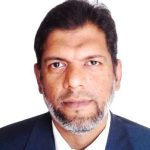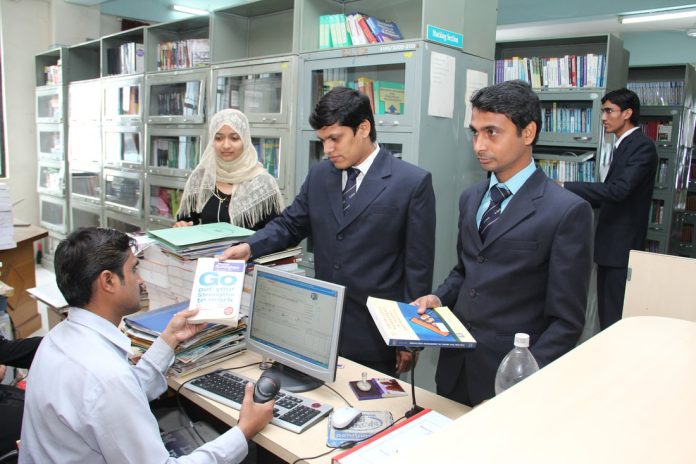
Arshad Shaikh studies the status of the Muslim community in India in Higher Education, referencing the latest All India Survey on Higher Education (AISHE). The data shows that Indian Muslims lag considerably on most indices of higher education. Education backwardness leads to economic backwardness, which affects other socio-political factors that shape the current situation of Muslims in India.
Every year since 2011, the Ministry of Education, Government of India has been coming out with the All India Survey on Higher Education (AISHE). The latest report AISHE 2020-2021 throws ample light on the state of higher education in the country, including its religious minorities. Higher education refers to the level beyond school that is graduate, post-graduate, and doctoral.
One of the important indices within the report is the Gross Enrollment Ratio (GER). It is a measure of the number of students enrolled for higher education as a percentage of their eligible population i.e. 18 to 23 years. While the national GER improved from 25.6% to 27.3%, for Muslims, the enrollment declined by a staggering 8% amounting to a drop of about 1.8 lakh students. The decline and deprivation among Muslims become even starker when compared with the enrollment for different communities (compared to 2019-20). For example, the enrollment for Scheduled Castes (SCs) improved by 4.2%, Scheduled Tribes (STs) by 11.9%, and Other Backward Classes (OBCs) improved by 4%.
If we check the decline in Muslim enrollment according to state, we find the biggest drop in Uttar Pradesh (36%), followed by Jammu and Kashmir (26%), Maharashtra (8.5%) and Tamil Nadu (8.1%). In the capital New Delhi, Muslim enrollment was quite dismal. Every fifth Muslim student failed to enroll in higher education after completing the Grade X Examination. The Muslim enrollment in higher education in Uttar Pradesh is about 4.5% of the population. In Kerala, the Muslim enrollment is 43%, which is higher than the national average.
The total enrollment in higher education is 4,13,80,71 students (about 4.6%). Despite the general perception that more Muslim girls are studying in schools and colleges, the AISHE Report shows that the Gender distribution for Muslims in higher education is female students: 48.67% and male students: 51.33%.

Another important index is the number of teachers. If we study the distribution of teachers by social class, we see that teachers from the General Category make up 56% while the OBCs make up 32%, followed by the SCs with 9% and STs with 2.5%. Muslim teachers make up only 5.6% of all teachers in Higher Education. If we examine the Gender distribution among teachers, we find that overall there are 75 female teachers for every 100 male teachers. The OBCs and STs have 71 and 75 female teachers per 100 male teachers and for Muslims, the ratio drops to 59 female teachers for every 100 male teachers. For non-teaching staff, while Other Minority Communities have 85 females for every 100 males, Muslims have only 34 females for every 100 males.
Some of the reasons why Muslims lag in higher education are:
(1) Enrollment Decline: Findings from the All India Survey on Higher Education (AISHE) underscore the urgency of examining the factors responsible for the decreasing enrollment rates among Muslim students. This decline is particularly concerning, especially when enrollment rates for other disadvantaged communities have exhibited positive trends.
(2) Labor Market Bias: Reports issued by the Centre for Monitoring the Indian Economy (CMIE) reveal that Muslims face a higher unemployment rate in comparison to individuals from other religious backgrounds. This statistic also reflects the presence of deep-seated discrimination within the job market, creating significant barriers to employment opportunities for Muslim individuals.
(3) Marginalization and Violence: The rise in violence against Muslims has not only curtailed their freedom of movement but has also led to their confinement within marginalized communities, as evidenced by the process of ghettoization in numerous cities. This marginalization casts its dark shadow on higher education and public employment, a grim reality underscored by reports such as those by the Sachar Committee and Ranganath Misra Commission. These reports emphasize the necessity for affirmative action policies aimed at mitigating the disadvantages faced by Muslims.
(4) Inadequate Representation: The AISHE survey brings to light the glaring underrepresentation of Muslim educators within higher education institutions. Shockingly, Muslims comprise a mere 5.6% of the total teaching workforce, highlighting a stark disparity when compared to other demographic groups. Furthermore, the representation of Muslim women in teaching positions remains conspicuously lower compared to their counterparts from other marginalized communities.
Various steps can be initiated to increase the number of Muslims in Higher Education. An important step would be to restore the Maulana Azad National Fellowship (MANF) program. It offers students from minority communities with financial assistance for education. This will ensure equitable access to higher education.
There must be scientific research and surveys to find out why the enrollment rate for Muslim students opting for higher education is going down. This may begin by investigating their high dropout rate at the school level. This investigation will help us figure out the reasons for this phenomenon and make plans to reverse this trend.
The government must come up with a special initiative for the creation of colleges and universities in Muslim-majority areas. This will help Muslim students acquire higher education more easily as well as contribute to the economy of the country.
Another disturbing phenomenon in India is the growing Islamophobia and discrimination against Muslims in educational institutions. The hijab ban on Muslim girls in Karnataka is a case in point. There should be strict rules against such attempts to harass Muslims because of their religion.
Targeted scholarships, mentorship programs, and awareness campaigns are some of the ways to ensure greater participation of Muslims in education. Those in the highest echelons of power should understand that if their political ideology preaches them to discriminate against the Muslim community in India then it would be akin to “shooting yourself in the foot”.
By neglecting the nearly 200 million-strong Muslim community in the field of higher education, it would significantly bring down the national average and drag the nation’s quest from becoming a ‘Vishwaguru’ and an education superpower in the coming decades.




